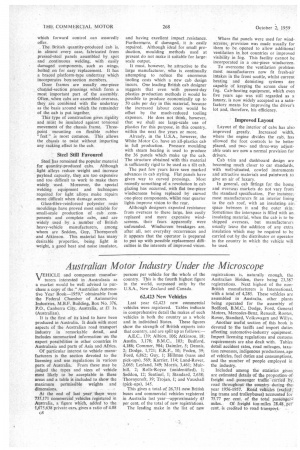Australian Motor Industry Under the Microscope
Page 110

If you've noticed an error in this article please click here to report it so we can fix it.
TEHICLE and component manufacV turers interested in Australasia as a market would be well advised to purchase a copy of the " Australian Automotive Year Book-1959," obtainable from the Federal Chamber of Automotive Industries, M.B.F. Building, Box No. 376, P.O., Canberra City, Australia, at £1 is. (Australian).
It is the first of its kind to have been produced in Australia. It deals with most aspects of the Australian road transport industry in remarkable detail, and includes summarized information on the export possibilities in other countries in Australasia and parts of Asia and Africa.
Of particular interest to vehicle manufacturers is the section devoted to the licensing and use regulations in various parts of Australia. From these may be judged the types and sizes of vehicle most likely to be acceptable in these areas and a table is included to show the maximum permissible weights and dimensions.
At the end of last year there were 735,171 commercial yehicles registered in Australia, a figure which, added to the 1,675,638 private cars, gives a ratio of 4.08 persons per vehicle for the whole of the country. This is the fourth highest figure in the world, surpassed only by the U.S.A., New Zealand and Canada.
62,423 New Vehicles
Last year 62,423 new commercial vehicles were registered. Tables indicate in comprehensive detail the makes of such vehicles in both the country as a whole and in individual States. These figures show the strength of British exports into that country, and are split up as follows:— A.E.C., 139; Albion, 106; Atkinson, 18; Austin, 3,178; B.M.C., 103; Bedford, 4,186; Commer, 984; Daimler, 5; Dennis, 2; Dodge, 1,721; E.R.F., 10; Foden, 39; Ford, 6,862; Guy, 1; Hillman (vans and pick-ups), 569; Karrier, 114; Land-Rover, 2,065: Leyland, 349; Morris, 3,461; Muirhill, 2; Rolls-Royce (unidentified), 1; Seddon, 12; Sentinel, 1; Standard, 2,638: Thornycroft, 39; Trojan, 1; and Vauxhall (pick-ups), 145.
This gives a total of 26,751 new British buses and commercial vehicles registered in Australia last year -approximately 43 per cent. of the total of new registrations.
The leading make in the list of new registrations is, naturally enough, the Australian Holden, there being 23,387 registrations. Next highest of the nonBritish manufacturers is International, with a total of 4,285. These vehicles are assembled in Australia, other plants being operated for the assembly of Bedford, B.M.C., Dodge, Ford, General Motors, Mercedes-Benz, Renault, Rootes, Rover, Standard, Volkswagen and Willys.
Another useful section of this book is devoted to the tariffs and import duties affecting automotive-industry equipment. Import licensing regulations and customs requirements are also dealt with. Tables detail accident rates, road mileages, taxation revenues, indigenous productions, age of vehicles, fuel duties and consumptions, and the number of people employed in the industry.
Included among the statistics given are estimated details of the proportion of freight and passenger traffic 'carried by, road throughout the country during the year 1956-1957. Road vehicles (excluding trams and trolleybuses) accounted for 75.77 per cent. of the total passenger
miles. Of freight ton-miles 28.48.. percent. is credited to road transport.












































































































































































































































